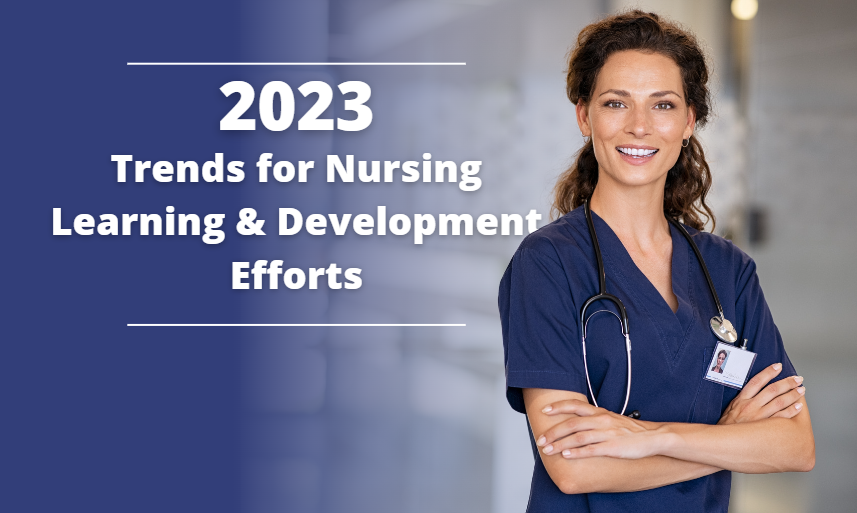What are nursing educators, instructors, and enterprise L&D leaders thinking as we head into 2023? In this article, Catalyst Learning reflects on well-cited nursing trends (staffing shortages, informatics, retention, need for leadership pipelines, etc.) and what we hear on-the-ground from nurse educators to understand and describe four priorities for NLD efforts in 2023.
CNOs/Educators Think about Nurse Leadership, Preparation, and Developing the Team
Most nurse executives agree that training and empowering nurses to lead is very important. Well prepared leaders, engaging teams lead to consistent quality outcomes for patients, increased staff satisfaction and lower turnover. Covid and its strain on staffing resources may have made it difficult for us to focus on developing strong nurse leaders but we’re seeing and hearing that developing nurse leaders will be a high priority in 2023. In 2023, we will see more organizations refocusing their efforts in preparing the first-level supervisory nurse to lead through crisis, manage with staff shortages, manage conflict, communicate better, and to delegate. Assessments and post-development surveys to measure outcomes will be critical to ensuring success.
For example , HCA is the largest for-profit health system in the U.S. HCA prepares each nurse leader (e.g., clinical coordinator, charge RN) with a curriculum on leadership. HCA calls this program it’s Nurse Leader Certificate Program, organized by HCA’s Leadership and Organizational Development team. Nurse Leader magazine featured a description of HCA’s rationale and results in this article, “Investing in the Front Line: Preparing the Best Nursing Leaders for the Next Generation.” Contact Catalyst Learning about starting a similar Charge Nurse program at your hospital or system.
Expansion of Culturally Competent Geriatric and Mental Health Care Education
With an increasing demand for quality geriatric care, mental health services and culturally competent care, skill development and competency will be critical. Nurse educators and instructors who recognize these trends are already spending more time on geriatric concepts and a holistic patient care for older adults. In addition, forward thinking Nursing Learning and Development professionals are increasing their focus on skills and competencies regarding patients experiencing mental health episodes as we continue to destigmatize these conditions and better care for patients experiencing them. In both these areas, like others, culturally competent care is essential and smart educators are weaving this into courses and learning activities. Many states are requiring, or will soon require, CE for nurses to help stay up to date with best mental health practices as we see more integration of primary care and behavioral health and as we gain greater understanding of how mental and physical health are intertwined.
Mathematical Prep, Data, Quantitative Reasoning L&D for Nurses
Data-driven technologies are reshaping diagnosis and care prescriptions. As a result, math and data skills and competencies for nursing are increasing. L&D leaders are noticing the need and are re-evaluating math, data, quantitative, and statistical education needs for nurses. While nursing programs require dosage calculations knowledge, the need to be able to interpret and analyze both mathematical and statistical information in contexts of patient data may not be in current curriculums and is a new requirement for nurses already working. The University of Texas Medical Center recommends math assessments for its nurses, to make sure they have quantitative and data reasoning skills which could affect clinical judgment. UT also recommends professional development opportunities that integrate best practices from nursing, mathematics, and statistics education. This is a great time to check in with college and university partners to ensure their curriculum is keeping up with your organization’s needs and review your current offerings for the same purpose.
Cross-Training Nurses in Non-Critical Areas to Fill Labor Needs
With staffing shortages across the country, hospitals are increasing looking to cross-training and additional support personnel to create a more a flexible workforce that can meet shifting staffing needs, provide nurses with support, and allow staff to take time off and recharge. Some organization are expanding or creating internal, highly crossed trained float pools to work across adjacent specialties as needs arise. There is good evidence that utilizing this type of flexibility can help redeploy labor resources easier and fast. In addition, some organizations are relooking at support care givers such as LPNs and unlicensed assistive personnel to take on more tasks and free up nurses This interdisciplinary team-based approach allows for rapid deployment of staff to areas of high need.
Nurse Retention 365, 24/7, Career-Long
In the past, organizations may have waited until a nurse resigned to find out why they were leaving whether to go to another employer, setting or even leave the profession. With today’s staffing realities, nurse leaders are putting strategies in place that build retention into every phase of employment starting with hiring and onboarding. While evidence suggests higher risk at beginning of a nursing career, nurse retention can be in peril throughout a career. At each opportunity building positive relationships with open communication can help us to understand the needs and aspirations of nurses allowing us intervene and problem solve when necessary. Having trong, competent and caring nurse leadership at all levels are the most powerful tool for retention. Learning and Development Educators through courses, activities and ways of growing great leaders and who understand retention can help ensure these efforts are successful.
“Nurses Predict Nursing and Healthcare Trends for 2023,” NurseJournal, November 24, 2022, Gayle Morris
“Nurses Guide to Caring for Patients with Mental Health Challenges,” NurseJournal, Laila Abdalla, May 18 2022
“Mathematics Education for Nurses – High quality mathematical preparation and quantitative reasoning for nurses” University of Texas at Austin – Charles A. Dana Center
“Convening Recommendations – Math and Statistics Education for Nurses,” dcmathpathways.org and University of Texas Charles A. Dana Center /Dana Center Mathematics Pathways
“Top Trends for Nursing Educators in 2023: Leadership, Mental Health and the Next Generation NCLEX Exam,” Jones & Bartlett Learning, Dec. 5 2022
“Cross-Training for Workforce Resiliency,” Minority Nurse, Michele Wojciechowski, Sept. 14 2021
